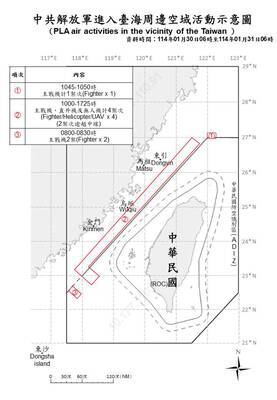The Philippine and Japanese navies yesterday held their first joint exercise in the South China Sea, as the two US allies boost security ties in the face of China’s growing pressure.
The drills followed the signing less than a month ago of an agreement between Manila and Tokyo to allow the deployment of troops on each other’s territory.
The Japanese destroyer JS Sazanami and the Philippine guided missile frigate BRP Jose Rizal took part in the two nations’ first bilateral “Maritime Cooperative Activity,” the Philippine military said in a statement.

Photo: AFP
“This activity was part of the ongoing efforts to strengthen regional and international cooperation towards realizing a free and open Indo-Pacific,” the statement said.
The two vessels held a communications exercise and undertook tactical maneuvers in the West Philippine Sea, Manila’s name for parts of the South China Sea that are closest to its coast.
These “enhanced the tactical capabilities of the Philippine Navy and the Japan Maritime Self-Defense Force and reinforced the strong ties and mutual commitment to maintaining peace and stability in the region,” the statement added.
A similar exercise was held two days earlier, also in South China Sea waters close to the Philippines, between the Philippine navy patrol ship BRP Ramon Alcaraz and the US Navy’s littoral combat ship USS Mobile.
The Philippines and Japan are longtime allies of the US, which has been strengthening its alliances from Canberra to Tokyo to counter China’s growing military might and influence in the region.
The deepening of Philippine-Japanese security ties comes as China’s saber rattling toward Taiwan and over the South China Sea fuels fears of a potential conflict that could drag in the US.
There have been escalating confrontations at sea between Chinese and Philippine vessels as Beijing steps up its efforts to push its claims to nearly all of the strategic South China Sea.

UNITED: The premier said Trump’s tariff comments provided a great opportunity for the private and public sectors to come together to maintain the nation’s chip advantage The government is considering ways to assist the nation’s semiconductor industry or hosting collaborative projects with the private sector after US President Donald Trump threatened to impose a 100 percent tariff on chips exported to the US, Premier Cho Jung-tai (卓榮泰) said yesterday. Trump on Monday told Republican members of the US Congress about plans to impose sweeping tariffs on semiconductors, steel, aluminum, copper and pharmaceuticals “in the very near future.” “It’s time for the United States to return to the system that made us richer and more powerful than ever before,” Trump said at the Republican Issues Conference in Miami, Florida. “They

GOLDEN OPPORTUNITY: Taiwan must capitalize on the shock waves DeepSeek has sent through US markets to show it is a tech partner of Washington, a researcher said China’s reported breakthrough in artificial intelligence (AI) would prompt the US to seek a stronger alliance with Taiwan and Japan to secure its technological superiority, a Taiwanese researcher said yesterday. The launch of low-cost AI model DeepSeek (深度求索) on Monday sent US tech stocks tumbling, with chipmaker Nvidia Corp losing 16 percent of its value and the NASDAQ falling 612.46 points, or 3.07 percent, to close at 19,341.84 points. On the same day, the Philadelphia Stock Exchange Semiconductor Sector index dropped 488.7 points, or 9.15 percent, to close at 4,853.24 points. The launch of the Chinese chatbot proves that a competitor can

TAIWAN DEFENSE: The initiative would involve integrating various systems in a fast-paced manner through the use of common software to obstruct a Chinese invasion The first tranche of the US Navy’s “Replicator” initiative aimed at obstructing a Chinese invasion of Taiwan would be ready by August, a US Naval Institute (USNI) News report on Tuesday said. The initiative is part of a larger defense strategy for Taiwan, and would involve launching thousands of uncrewed submarines, surface vessels and aerial vehicles around Taiwan to buy the nation and its partners time to assemble a response. The plan was first made public by the Washington Post in June last year, when it cited comments by US Indo-Pacific Commander Admiral Samuel Paparo on the sidelines of the Shangri-La Dialogue

MARITIME SECURITY: Of the 52 vessels, 15 were rated a ‘threat’ for various reasons, including the amount of time they spent loitering near subsea cables, the CGA said Taiwan has identified 52 “suspicious” Chinese-owned ships flying flags of convenience that require close monitoring if detected near the nation, the Coast Guard Administration (CGA) said yesterday, as the nation seeks to protect its subsea telecoms cables. The stricter regime comes after a Cameroon-flagged vessel was briefly detained by the CGA earlier this month on suspicion of damaging an international cable northeast of Taiwan. The vessel is owned by a Hong Kong-registered company with a Chinese address given for its only listed director, the CGA said previously. Taiwan fears China could sever its communication links as part of an attempt